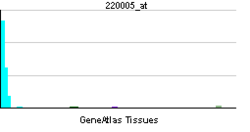- P2RY13
-
Purinergic receptor P2Y, G-protein coupled, 13 Identifiers Symbols P2RY13; GPCR1; GPR86; GPR94; P2Y13; SP174 External IDs OMIM: 606380 MGI: 1921441 HomoloGene: 12543 IUPHAR: P2Y13 GeneCards: P2RY13 Gene Gene Ontology Molecular function • receptor activity
• G-protein coupled receptor activity
• purinergic nucleotide receptor activity, G-protein coupledCellular component • endoplasmic reticulum
• plasma membrane
• plasma membrane
• integral to membraneBiological process • biological_process Sources: Amigo / QuickGO RNA expression pattern 
More reference expression data Orthologs Species Human Mouse Entrez 53829 74191 Ensembl ENSG00000181631 ENSMUSG00000036362 UniProt Q9BPV8 Q0VF10 RefSeq (mRNA) NM_023914 NM_028808.3 RefSeq (protein) NP_076403 NP_083084.2 Location (UCSC) Chr 3:
151.04 – 151.05 MbChr 3:
59.01 – 59.01 MbPubMed search [1] [2] P2Y purinoceptor 13 is a protein that in humans is encoded by the P2RY13 gene.[1][2][3]
The product of this gene, P2Y13, belongs to the family of G-protein coupled receptors. This family has several receptor subtypes with different pharmacological selectivity, which overlaps in some cases, for various adenosine and uridine nucleotides. This receptor is activated by ADP. Two transcript variants encoding the same protein have been identified for this gene.[3]
Contents
See also
References
- ^ Wittenberger T, Schaller HC, Hellebrand S (Mar 2001). "An expressed sequence tag (EST) data mining strategy succeeding in the discovery of new G-protein coupled receptors". J Mol Biol 307 (3): 799–813. doi:10.1006/jmbi.2001.4520. PMID 11273702.
- ^ Lee DK, Nguyen T, Lynch KR, Cheng R, Vanti WB, Arkhitko O, Lewis T, Evans JF, George SR, O'Dowd BF (Sep 2001). "Discovery and mapping of ten novel G protein-coupled receptor genes". Gene 275 (1): 83–91. doi:10.1016/S0378-1119(01)00651-5. PMID 11574155.
- ^ a b "Entrez Gene: P2RY13 purinergic receptor P2Y, G-protein coupled, 13". http://www.ncbi.nlm.nih.gov/sites/entrez?Db=gene&Cmd=ShowDetailView&TermToSearch=53829.
External links
- "P2Y Receptors: P2Y13". IUPHAR Database of Receptors and Ion Channels. International Union of Basic and Clinical Pharmacology. http://www.iuphar-db.org/GPCR/ReceptorDisplayForward?receptorID=3034.
Further reading
- Communi D, Gonzalez NS, Detheux M, et al. (2001). "Identification of a novel human ADP receptor coupled to G(i).". J. Biol. Chem. 276 (44): 41479–85. doi:10.1074/jbc.M105912200. PMID 11546776.
- Zhang FL, Luo L, Gustafson E, et al. (2002). "P2Y(13): identification and characterization of a novel Galphai-coupled ADP receptor from human and mouse.". J. Pharmacol. Exp. Ther. 301 (2): 705–13. doi:10.1124/jpet.301.2.705. PMID 11961076.
- Takeda S, Kadowaki S, Haga T, et al. (2002). "Identification of G protein-coupled receptor genes from the human genome sequence.". FEBS Lett. 520 (1–3): 97–101. doi:10.1016/S0014-5793(02)02775-8. PMID 12044878.
- Strausberg RL, Feingold EA, Grouse LH, et al. (2003). "Generation and initial analysis of more than 15,000 full-length human and mouse cDNA sequences". Proc. Natl. Acad. Sci. U.S.A. 99 (26): 16899–903. doi:10.1073/pnas.242603899. PMC 139241. PMID 12477932. http://www.pubmedcentral.nih.gov/articlerender.fcgi?tool=pmcentrez&artid=139241.
- Fabre AC, Malaval C, Ben Addi A, et al. (2010). "P2Y13 receptor is critical for reverse cholesterol transport". Hepathology. 52 (4): 1477–83. doi:10.1002/hep.23897. PMID 20830789.
Metabolites and
signaling moleculesOtherBile acid · Cannabinoid (CB1, CB2, GPR (18, 55, 119)) · EBI2 · Estrogen · Free fatty acid (1, 2, 3, 4) · Lactate · Lysophosphatidic acid (1, 2, 3, 4, 5, 6) · Lysophospholipid (1, 2, 3, 4, 5, 6, 7, 8) · Niacin (1, 2) · Oxoglutarate · PAF · Sphingosine-1-phosphate (1, 2, 3, 4, 5) · SuccinatePeptideOtherAnaphylatoxin (C3a, C5a) · Angiotensin (1, 2) · Apelin · Bombesin (BRS3, GRPR, NMBR) · Bradykinin (B1, B2) · Chemokine · Cholecystokinin (A, B) · Endothelin (A, B) · Formyl peptide (1, 2, 3) · FSH · Galanin (1, 2, 3) · GHB receptor · Gonadotropin-releasing hormone (1, 2) · Ghrelin · Kisspeptin · Luteinizing hormone/choriogonadotropin · MAS (1, 1L, D, E, F, G, X1, X2, X3, X4) · Melanocortin (1, 2, 3, 4, 5) · MCHR (1, 2) · Motilin · Opioid (Delta, Kappa, Mu, Nociceptin & Zeta, but not Sigma) · Orexin (1, 2) · Oxytocin · Prokineticin (1, 2) · Prolactin-releasing peptide · Relaxin (1, 2, 3, 4) · Somatostatin (1, 2, 3, 4, 5) · Tachykinin (1, 2, 3) · Thyrotropin · Thyrotropin-releasing hormone · Urotensin-II · Vasopressin (1A, 1B, 2)MiscellaneousGPR (1, 3, 4, 6, 12, 15, 17, 18, 19, 20, 21, 22, 23, 25, 26, 27, 31, 32, 33, 34, 35, 37, 39, 42, 44, 45, 50, 52, 55, 61, 62, 63, 65, 68, 75, 77, 78, 81, 82, 83, 84, 85, 87, 88, 92, 101, 103, 109A, 109B, 119, 120, 132, 135, 137B, 139, 141, 142, 146, 148, 149, 150, 151, 152, 153, 160, 161, 162, 171, 173, 174, 176, 177, 182, 183)OtherClass B: Secretin like OtherBrain-specific angiogenesis inhibitor (1, 2, 3) · Cadherin (1, 2, 3) · Calcitonin · CALCRL · CD97 · Corticotropin-releasing hormone (1, 2) · EMR (1, 2, 3) · Glucagon (GR, GIPR, GLP1R, GLP2R) · Growth hormone releasing hormone · PACAPR1 · GPR · Latrophilin (1, 2, 3, ELTD1) · Methuselah-like proteins · Parathyroid hormone (1, 2) · Secretin · Vasoactive intestinal peptide (1, 2)Class C: Metabotropic
glutamate / pheromoneOtherClass F:
Frizzled / SmoothenedFrizzledSmoothenedCategories:- Human proteins
- Transmembrane receptor stubs
- G protein coupled receptors
Wikimedia Foundation. 2010.
